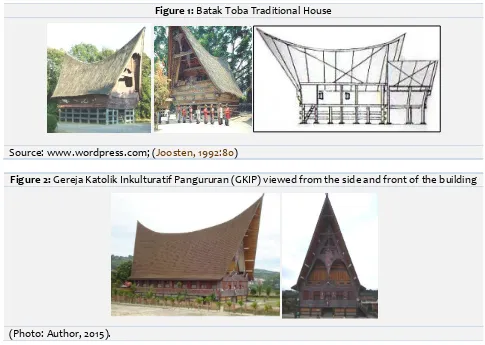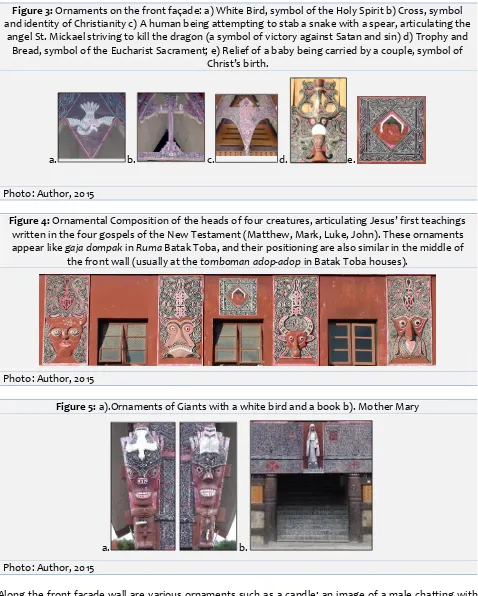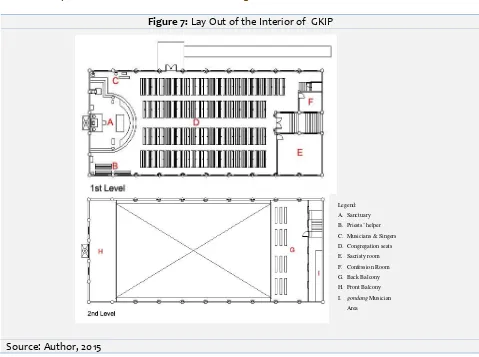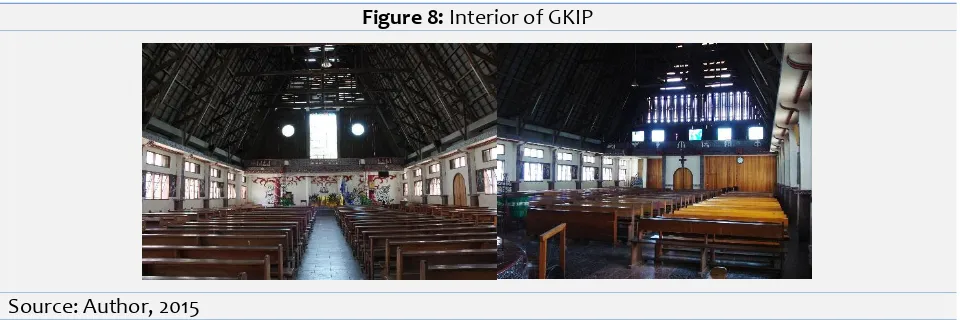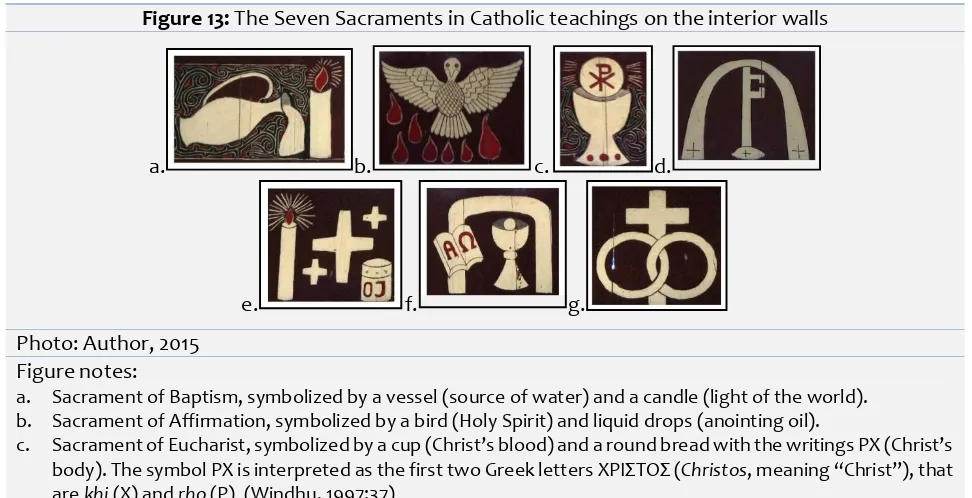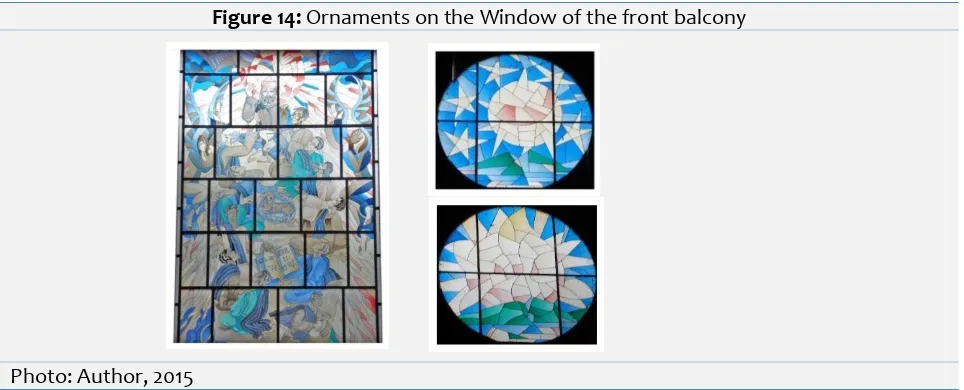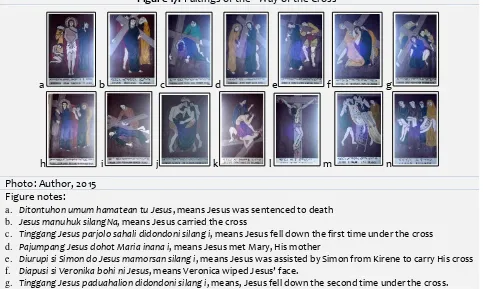J
ournal of
A
rts &
H
umanities
ISSN: 2167-9045 (Print), 2167-9053 (Online)
Study of Ornaments in the Inkulturatif Pangururan
Catholic Church in Samosir, North Sumatera
Ronald Hasudungan Irianto Sitindjak
1, Laksmi Kusuma Wardani
1, Diana Thamrin
1ABSTRACT
In the early 1900s, Catholic missionaries arrrived on Batak land in North Sumatera, Indonesia and initiated the process of inculturation, which was subsequently marked by the adaptation of Catholic teachings with the Batak traditional culture. The adaptation involved the liturgy, music and others, inculding the architecture and interior design of their places of worship that continued even to the Modern times. This research aims to discover the meaning behind the ornaments on the exterior and interior of the Inkulturatif Pangururan Catholic Church in Samosir, North Sumatera, as a result of this inculturation process, through Panofsky’s research method known as Iconology. The elements analyzed include the façade, enclosure elements, transitional elements and filling elements. Results show that the ornaments contain various meanings inculturated from Catholic culture having biblical and theological themes incorporated into Batak Toba stylized ornamental forms. This shows that the goodness, truth and beauty of the Catholic faith had honored and adapted their teachings to the local wisdom and culture such that what appears in the implementation of the ornaments is a novel creative beauty and an embodiment of inculturation.
Keywords: Catholic church, meaning, ornament, inculturation. Available Online: 21st July, 2016.
This is an open access article under Creative Commons Attribution 4.0 License, 2016.
1.0
Introduction
In the year 1878 , Medan, an area belonging to the Melayu race that is close to Batak land, became a Catholic station with C. Wenneker as the first priest (van den End, 2000:420). Following subsequent developments, in the year 1914, Catholicism arrrived on the Batak land and initiated the process of inculturation, which was marked by the adaptation of Catholic teachings with the Batak traditional culture. This adaptation involved the liturgy, music and others, inculding the architecture and interior
Sitindjak et al. , JAH (2016), Vol. 05, No. 07: 49-60
design of their places of worship (Prier, 1999:28; van den End, 2000:449), reflecting the intermingling of cultures and inculturation that continued till the Modern times.
Today, one of the buildings that evidently reflects this unique process of inculturation is the Inkulturatif
Santo Mikael Pangururan Catholic Church or more familiarly known as Gereja Katolik Inkulturatif
Pangururan (GKIP). This church is located on Putri Lopian Street, Panguruan, Samosir, North Sumatera,
Indonesia. It is a new building with a capacity of ± 700 people. GKIP was constructed in 1994-1997, and was inagurated on the 27th of June 1997 by Bishop Agung Medan Mgr. AGP Batubara, OFM Cap and Regent Tapanuli Utara Drs. TMH Sinaga. Priest Leo Joosten, OFM Cap (a Dutch priest) directly led the contruction of the GKIP building with help from achitectural planners namely: (1) Bruder Anianus Snik, OFM Cap, a Dutch man who was responsible for the building construction, and (2) Toga Nainggolan, a Batak Toba person who was responsible for the Batak Toba architectural features of the church.
This Catholic church posseses a vernacular style of architectural form, a style that is based on and influenced by site/local/native factors. In this sense, the architectual form of the GKIP building shows similarities to the traditional architecture of Batak Toba (figure 1 and 2), including the application of ornaments on the exterior wall surfaces. Similarities could be found on the the large and looming gabled roof form with its eaves slanted outwards, a balcony as its front porch and various ornaments (gorga) on the main facade that symbolises the social status of the building’s owner (Tjahjono, 2002:24).
Figure 1: Batak Toba Traditional House
Source: www.wordpress.com; (Joosten, 1992:80)
Figure 2: Gereja Katolik Inkulturatif Pangururan (GKIP) viewed from the side and front of the building
(Photo: Author, 2015).
Study of ornaments in the Inkulturatif Pangururan ...
paper can contribute to the conservation of unique heritage values and encourage future cultural integrations in all fields of knowledge in the contemporary society.
2.0
Research method
This research attempts to discover the meanings of the ornaments on the exteriors and interiors of the Inkulturatif Pangururan Catholic church (GKIP) using the Panofsky iconological approach. The method starts with the stage of Pre-iconography or the primary subject matter. The objects to be interpreted were first described in regard to their primary meaning (factual and expressional meaning), textually based on the artistic world, in which interpretations were drawn through practical experiences as well
experiences towards the objects’ reality. Their corrective principles were described based on history of
style (Panofsky, 1955:40-41). In the stage of Iconography, the objects were then interpreted with secondary/conventional meanings, based on the world of images, emblems and symbols. Their interpretations were obtained through literature resources having specific themes and concepts. Hence, their corrective principles were based on the history of types(Panofsky, 1955:40-41). Moving forward to the stage of Iconology, the interpretations of the objects were then described with intrinsic/content meanings, based on the symbolic world. The interpretations were obtained through synthetic intuition, or various essential tendencies of the human mind that depends on personal psychological factors termed as “weltanschaining” or life view of a certain nation. Their corrective principles were based on the history of cultural and symbolic symptoms (Panofsky, 1955:40-41).
The data were collected through three steps: literature studies, observation and interview. The research object was specifically limited to the ornaments on the exterior and interior of the GKIP building, bearing the consideration that ornaments are formed by two basic elements: motif and pattern. Motifs are grouped according to their forms whether organic, inorganic or artificial. Patterns are the organisation systems of motifs into a particular arrangement. Patterns could be achieved through copying, scaling, gradation, mirroring, rotating, and so on. These patterns are organized into a particular arrangement or repetition that could be done horizontally, vertically, diagonal or combination of all. Thus, ornaments are a system of organized motifs designed to produce various patterns. A motif can be singular or stand alone and can also be combined with other motifs altogether (Guntur, 2001: 93-96).
3.0
Results and discussion
Ornamental forms on the exteriors of GKIP
The ornaments on the exteriors of the GKIP building can be seen on the front and side facades (figures 3-6). However, they are dominant on the front façade. They have been designed and applied according to the concept of Ruma Batak Toba, or the traditional Batak Toba house known as gorga. The ornament of giants with a white bird and a book located on the corners of the front façade show a similarity to the
singa-singa ornaments in Ruma Batak Toba. Singa-singa is a symbol of truth and justice. A white bird on
the forehead suggests a dove that is a symbol of the Holy Spirit. The Holy Spirit is a representation of God
descending on Earth. Meanwhile the book on the right giant’s forehead is a symbol of the Holy Bible,
Sitindjak et al. , JAH (2016), Vol. 05, No. 07: 49-60
Figure 3: Ornaments on the front façade: a) White Bird, symbol of the Holy Spirit b) Cross, symbol and identity of Christianity c) A human being attempting to stab a snake with a spear, articulating the
angel St. Mickael striving to kill the dragon (a symbol of victory against Satan and sin) d) Trophy and Bread, symbol of the Eucharist Sacrament; e) Relief of a baby being carried by a couple, symbol of
Christ’s birth.
a. b. c. d. e.
Photo: Author, 2015
Figure 4:Ornamental Composition of the heads of four creatures, articulating Jesus’ first teachings written in the four gospels of the New Testament (Matthew, Mark, Luke, John). These ornaments appear like gaja dompak in Ruma Batak Toba, and their positioning are also similar in the middle of
the front wall (usually at the tomboman adop-adop in Batak Toba houses).
Photo: Author, 2015
Figure 5: a).Ornaments of Giants with a white bird and a book b). Mother Mary
a. b.
Photo: Author, 2015
Along the front façade wall are various ornaments such as a candle; an image of a male chatting with animals, birds, sheep, and a cross; a cross, cup and bread; two angels bowing before the holy bread and cross; a book and bird; A (Alfa) and Ω (Omega) symbols; fish and a basket of bread; an image of a male touching a female who is kneeling, depicting St. Francist and St. Clara. A striped motived ornament in red, white and black colours appear dominantly, filling the empty spaces and thus acting as a background on the front, left, right and back walls of the GKIP. These ornaments are similar in both form and colour to those with tendrils and curved plants like the motifs dalihan na tolu, desa na ualu, simatani ari,
Study of ornaments in the Inkulturatif Pangururan ...
Figure 6: The exterior wall of buiding are filled with cruved plants like those in the Ruma Batak Toba
Photo: Author, 2015
Geometrical ornaments arranged in a repetitive manner are located on the corners of the larger ornaments. These ornaments are similar to the ipon-ipon in the Ruma Batak Toba, having a varitety of form but still geometric in general, and function as decoration on the corners. These ornaments have been designed with Christian themes and also appear on the right and left of the building.
Interpretation of the ornamental meanings in the interior of GKIP
Figure 7: Lay Out of the Interior of GKIP
Source: Author, 2015
The interior of the church has a spacious rectangular form without partitions as shown in layout plan (figure 7) and have a very tall ceiling, united with its roof that covers it (figure 8). On the front area is the sanctuary, a place where the priests lead the Eucharist sacrament and thus is considered a sacred place. In this area is the sedilia (the priest chair), altar, and rostrum. As mentioned, the sanctuary is considered
a holy place. On the left of the sanctuary there are seats for the priests’ helpers (deacon, acolyte, and
Legend: A. Sanctuary B. Priests’ helper C. Musicians & Singers D. Congregation seats E. Sacristy room F. Confession Room G. Back Balcony H. Front Balcony I. gondang Musician
Sitindjak et al. , JAH (2016), Vol. 05, No. 07: 49-60
other workers) and the right side are the seats of the song leaders and musicians. This arrangement is similar to the interior arrangement of Ruma Batak Toba, having a balcony on the front and the back.
The middle area is the congregation sitting area functioning as a space for the congregation to celebrate the Eucharist. In this area, there are bench seatings having knee supporters for kneeling. The benches were arranged into four rows, forming five circulation rows with the congregation area as the center. On the back area below the back balcony is an enclosed area which is the Sacristy room, a preparation place for the priests before leading the liturgy. This room also functions as a place for storing communion tools. Another enclosed space on the back area is the Confession Room, a place to receive the sacrament of reconciliation personally. This room is usually used during the Lent and Advent period.
Figure 8: Interior of GKIP
Source: Author, 2015
The ornaments in the interior of service area can be seen on the walls, doors, windows, stairs and columns (figure 9). The ornaments on the left wall are reliefs of male and female figures harvesting fruits from a tree. On the tree is an image of a snake directing its face to the female. This illustrates the beginning when human beings fell into the world of sin. The first human beings, Adam (male) and Eve (female), created by God and lived in the Garden of Eden/Paradise, both ate the forbidden fruit of good of evil. The tree articulates the human life that constantly faces both good and evil/sin in this world.
The middle wall contains an image of a male figure spreading both his hands to the left and right like a cross on the tree. This illustrates Jesus who died on the cross to save humans from their sins. Jesus was pictured nailed to the cross on the trunk whereas the human beings (his church) appear on the branches. Thus, humans who believe in Christ ought to be ready to bear the cross, or in this sense, ready to face the trials of life. The image of being nailed to the cross is then followed by the death and ressurection of Jesus. This means that as God’s followers, believers after being released from sin, ought to be born again in truth in their new life and become God’s helpers to implement His teachings in everday life.
The wall on the right contains images of angels worshiping a tree, where on the tree is a box called the Tabernacle. It is the symbol of the presence of Christ among his church. His presence is exalted and
praised by the angels, articulating Christ’s victory over sin and death. Christ is illustrated to be present in
Study of ornaments in the Inkulturatif Pangururan ...
Figure 9: Image of the tree of life on the left, front and right of the service area.
Photo: Author, 2015
The tree ornaments contain meanings referring to the three trees of human life. The first tree articulates the fall of man into sin. The second articulates the atonement from sin through the death of Christ on the cross. The third articulates the ressurection of Christ, implying the spirit of God staying and living inside the heart of every human being who believes in Him.
Figure 10: Image of Harvesting Activities
Photo: Author, 2015
On the left and right of the front balcony there are also images of human beings doing harvesting activities (figure 10), an articulation of everyday life of the Batak Toba people, who were mainly farmers working in fields and gardens. The yields of harvest are materials that could be managed to become food, in this case, interpreted as the holy bread usually eaten by the congregation during the Eucharist
sacrament. Bread is the symbol of Christ’s body who had undergone tribulation. Thus, these ornaments
have blended themes of Christianity with the anthropologicial views of the Batak Toba society.
Figure 11: a) Images of book and candle, b) Writings in Batak character
a. b. Photo: Author, 2015
In the middle part, there are other decorations having images of a book with Batak writings, a candle and a line of Batak writing”Ahu Do Roti Hangoluani” (figure 11). In the Christian context, the book together with the candle clarify the Christian holy scriptures, the Bible, as the Light of God. The Batak writings on the book is to indicate that the source of Christian teachings is the bible and that It has entered the Batak culture and society. The writings “Ahu Do Roti Hangoluani” translates to ”I am the Living Bread”. The
meaning of this teaching is that the bible is the basic need of God’s people in their every day life. Just as
Sitindjak et al. , JAH (2016), Vol. 05, No. 07: 49-60
Other ornaments could be found on the lower wall of the front balcony (figure 12) which are in the form of spiral lines that are red, black and white in colour. They fill in the empty spaces and act as a background to the primary ornaments. This form of decoration is similar to the ornaments in the Ruma Batak Toba, particularly the curvy plants or tendrils such as the dalihan na tolu, desa na ualu, simatani ari, simeol-meol,
silintong and more. Besides that, there are also geometric ornaments that were arranged in an orderly
and repetetive manner and blended with the colours red, white and black. Their location is on the sides of the ornaments that are bigger in size. These ornaments are similar to the ipon-ipon ornaments in the
Ruma Batak Toba.
Figure 12: Ornaments on the balcony showing tendrils such as motifs of dalihan na tolu, desa na ualu,
simatani ari, simeol-meol, silintong in the Ruma Batak
Photo: Author, 2015
On the lower wall of the back balcony, there are seven Christian symbols that have been adapted to Batak Toba ornaments. (figure 13). The number seven reminds people of the seven sacraments in Catholic teachings as stated in the Compendium Catechism of the Catholic Church. A sacrament is a symbol that brings grace and could be grasped by the five human senses. The seven sacraments consist of Baptism, Affirmation, Eucharist, Repentance, Anointing of the Sick, Ordination, and Marriage. In every sacrament, the grace of the Holy Spirit is given by God. This grace enables believers in their journey towards holiness, assisting the church to grow in love and testimony in the world. The symbols of sacrament originate from creation (light, water, fire, grape, oil), social life activities (washing, anointing, breaking of bread), and the history of salvation in the Old Testament (Passover rites, sacrifice, the laying of hands, sanctification). These symbols, that are normative and unchangable in nature, were taken by Christ and used in salvation and santification.
Figure 13: The Seven Sacraments in Catholic teachings on the interior walls
a. b. c. d.
e. f. g.
Photo: Author, 2015 Figure notes:
a. Sacrament of Baptism, symbolized by a vessel (source of water) and a candle (light of the world). b. Sacrament of Affirmation, symbolized by a bird (Holy Spirit) and liquid drops (anointing oil).
Study of ornaments in the Inkulturatif Pangururan ...
d. Sacrament of Repentance, symbolized by a stole (power of the priesthood) and key (spiritual authority) e. Sacrament of the Anointing of the Sick, symbolized by a candle (Christ as the light of the world), cross
(Christ’s victory), and a cup with a OJ sign (oil for the sick).
f. Sacrament of Ordination, symbolized by the sign AΩ (beginning and the end), stole (power of priesthood), as well as a cup and communion bread (symbol of Eucharist implemention)
g. Sacrament of Marriage, symbolized by a cross (Christ’s victory over death) and two interlocking rings (marriage bond with Christ as the unifier)
On the main door are ornaments in the form of wooden reliefs (figure 14). There are twelve reliefs in total, illustrating the Creed of the Apostles (12 Faith of the Apostles). These creeds are the faith testimonies of the Catholic people and the symbols are ancient baptismal symbols of the Roman Church. Besides decoration for the entrance, they function as reminders of their faith before entering the door to the place of worship. The round window on the left is a symbol of the moon and stars, refering to the dark or night. Meanwhile, the round window on the right symbolizes the sun, refering to the light or day. The rectagular window in the middle contains an image of a banquet, having a book with writings written Exodus 12:1-14 and 1 Corinthians 11:23-27, and these refer to passages in the Holy Bible. Exodus 12:1-14 is the passage about the celebration of the Passover in the time of Moses and the Israelites in Egypt, their land of slavery, whereas 1 Corinthians 11:23-27 is the passage about the apostle Paul reminding the Corinthian church of the last supper of Jesus with His disciples. These two passages has a similar meaning that indicates giving an offering of sacrifice.
Figure 14: Ornaments on the Window of the front balcony
Photo: Author, 2015
The windows of the back balcony consist of five squared windows, containing images that together narrate a story or a legend from Batak land that has been processed and adapted to Catholic theological themes, hence producing a novel meaning regarding the entrance of Catholicsim on the land of Batak. It has been designed to be viewed in a sequence from left to right, as shown in figure 15.
Figure 15: Ornaments of the windows of the back balcony
a. b. c. d. e.
Photo: Author, 2015 Figure notes:
Sitindjak et al. , JAH (2016), Vol. 05, No. 07: 49-60
b. Image of life in water, signifying Earth that was created by the Princess. In this context, it refers to Danau Toba or the Toba Lake, the lake of the Batak people.
c. Image of life in water, signifying Earth that was created by the Princess. In this context, it refers to Danau Toba or the Toba Lake, the lake of the Batak people.
d. Image of a woman and a snake, Signifying the Princess fighting with the Dragon Snake (dragon padoha) a symbol of evil. This refers to the strive of Christianity against evil during its arrival on Batak land. The image of a bird and holy scripture symbolises the Holy Spirit and the God’s Word descending on Batak land defeating the snake dragon and thus transforming Batak land into a Christian land.
e. Image of a woman blowing a musical instrument. It symbolises the Princess worshiping and praising God’s victory.
The primary filling elements in the church are the tabernacle and the rostrum (figure 16). The tabernacle is located in the sanctuary, attached to the column that unites with the reliefs on the wall. It functions as the storage place for sacraments, such as the communion bread (Christ’s body) that has been sanctified the process of Consecration in the celebration of the Eucharist. The term “tabernacle” means “tent,” the place where Jesus Christ himself resided. Thus, His people ought to give honour to the tabernacle by kneeling before it. The tabernacle is rectangular in form, with reliefs of the holy family: Mary, Joseph and Baby Jesus. The door is gold in colour. On its sides, there are geometrical ornaments that are similar to
the ipon-ipon ornaments of Batak Toba. The left and right sides of the tabernacle are also rectangular,
consisting of motifs of spiral lines that are red, white and black in colour. These ornament resemble the tendril motifs of Batak Toba ornaments. On the part of the supporting rack of the tabernacle, there are straight lines and half circles that have been arranged in a layered and repetitive pattern to decorate the sides, again red, white and black in colour. These also resemble the ipon-ipon ombun marhehe ornament in the ornamental culture of Batak Toba.
Figure 16: Tabernacle and the Santuary Rostrum
Photo: Author, 2015
The rostrum in the sanctuary is made of wood that has been carved with Batak Toba ornaments. The function of the rostrum is as a place to give speech from the holy scriptures, lead the holy service, read out scripture passages, lead prayers and give announcements. On the upper part of the rostrum, there is an ornamental image of a book (symbol of the Bible) with Batak writings. Wheras, on the background of the rostrum, are spriral line motifs that are red, white and black in colour, similar to the tendril ornaments of Batak Toba. On the sides of the rostrum there are decorations containing half circles arranges in a layered and repetitive pattern, red, white and black in colour, similar to the ipon-ipon ombun marhehe of the Batak Toba ornament. Meanwhile, the foot of the rostrum contains geometrical ornaments arranged repetitively, resembling the ipon-ipon of Batak Toba ornaments.
Study of ornaments in the Inkulturatif Pangururan ...
walls and given captions in Batak characters. They function as a reminder for the congregation of Christ’s sacrifice on the cross for their sins, the ultimate work of salvation given to those who believe in Him.
Figure 17:Paitings of the ”Way of the Cross”
a b c d e f g
h i j k l m n Photo: Author, 2015
Figure notes:
a. Ditontuhon umum hamatean tu Jesus, means Jesus was sentenced to death
b. Jesus manuhuk silangNa, means Jesus carried the cross
c. Tinggang Jesus parjolo sahali didondoni silang i, means Jesus fell down the first time under the cross
d. Pajumpang Jesus dohot Maria inana i, means Jesus met Mary, His mother
e. Diurupi si Simon do Jesus mamorsan silang i, means Jesus was assisted by Simon from Kirene to carry His cross
f. Diapusi si Veronika bohi ni Jesus, means Veronica wiped Jesus’ face.
g. Tinggang Jesus paduahalion didondoni silang i, means, Jesus fell down the second time under the cross.
h. Diapuli Jesus angka boru boru na manangisi Ibana, means Jesus adviced the women who were crying for Him.
i. Tinggang Jesus patoluhalion didondoni silang i, means Jesus fell the third time under the cross.
j. Ditanggali pahean ni Jesus jala dilehon inunonna na paet, means Jesus’ clothes were detached from Him
k. Jesus dipatimbo tu silang i, means Jesus was nailed to the cross.
l. Jesus mate tarsilang, means Jesus died on the cross.
m.Jesus dipaijur sian silang i, means Jesus was taken down from the cross.
n. Jesus ditanom, means Jesus was buried.
4.0
Conclusions and Recommendations
The ornaments on the building of the Gereja Katolik Inkulturatif Pangururan (or the Inkulturatif Panguruan Catholic Church) contain blended meanings as a result of adaptation of Catholic culture with its theological themes to the traditional ornamental culture of Batak Toba. Some were inspired by local cultural legends, symbols of livelihood, daily life of its people and the ornaments attached to the traditional buildings of Batak Toba. The blending of cultures could be seen in the ornaments on the exteriors of the building namely the front, left and right facades. In the interiors, the blending of cultures could be seen in the ornaments on the enclosure elements (front walls, lower wall of the front balcony, the main entrance, the windows of the front balcony, columns) as well as on the filling elements (tabernacle, rostrum, water container, cross, and the ornaments on the “Way of the Cross”). The results of the blending and adaptation of Catholicism to the Batak Toba culture shows that the ornaments designed contain inculturated meanings consisting of Catholic theological themes with stylized Batak Toba ornaments. At the same time, they also indicate the goodness and truthfulness of the Catholic religion in adapting their teachings to the local wisdom of the Batak Toba culture. Hence, what appears
in the implementation of the church’s building ornaments is a novel beauty and representation of
inculturation.
Sitindjak et al. , JAH (2016), Vol. 05, No. 07: 49-60
References
Germain, S., and Van der Goes, B., (2001). Batak Architecture of Sumatra. In Tjahjono, Gunawan (Ed)
Indonesian Heritage: Architecture, (24-25). Singapore: Archipelago Press.
Guntur. (2001). Studi Ornamen, Sekolah Tinggi Seni Indonesia, Surakarta. Joosten, P. L.,(1992). Samosir, the Old Batak Society, Pematangsiantar.
Panofsky, E., (1955). Meaning in the Visual Arts. Chicago: University of Chicago Press. Prier, K.E., (1999). Inkulturasi Musik Liturgi. PML, Yogyakarta.
Van den End, Th. & Weitjens. J., (2000). Ragi Carita: Sejarah Gereja di Indonesia 2 (1860an-sekarang). BPK Gunung Mulia, Jakarta.
